外研版(2019)必修第三册 Unit4 Amazing art Using language 优质课件(共35张PPT)
文档属性
| 名称 | 外研版(2019)必修第三册 Unit4 Amazing art Using language 优质课件(共35张PPT) | 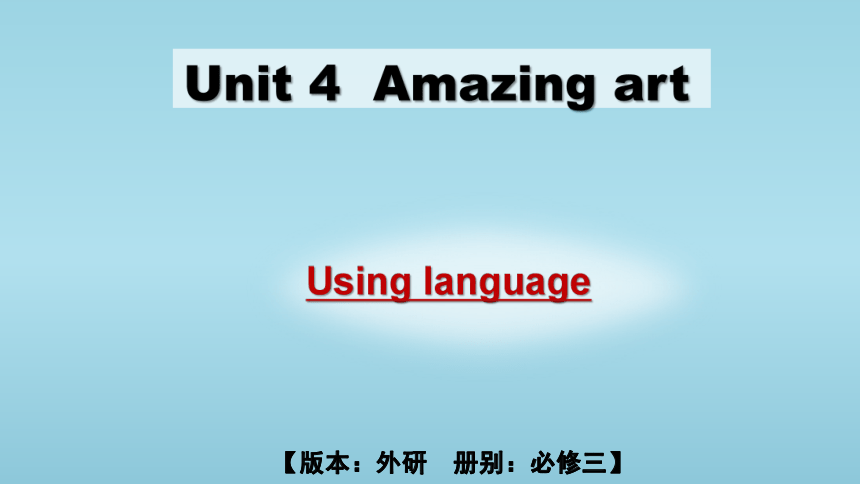 | |
| 格式 | pptx | ||
| 文件大小 | 5.0MB | ||
| 资源类型 | 教案 | ||
| 版本资源 | 外研版(2019) | ||
| 科目 | 英语 | ||
| 更新时间 | 2023-03-01 16:09:11 | ||
图片预览


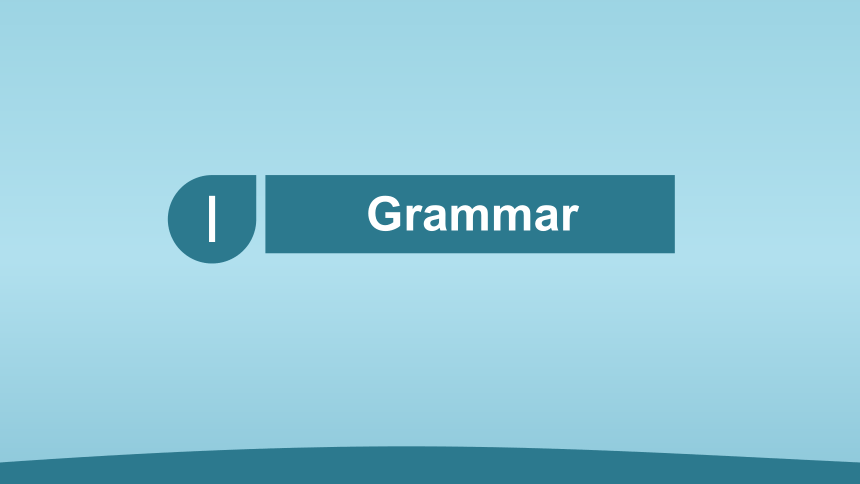
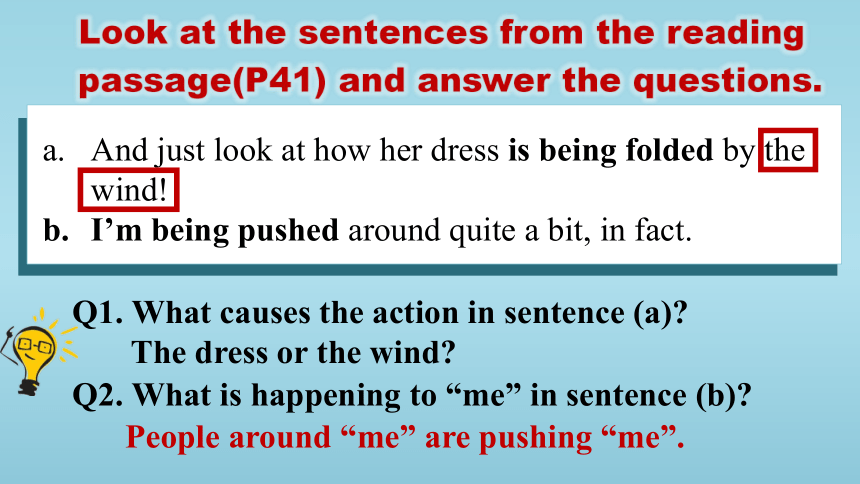

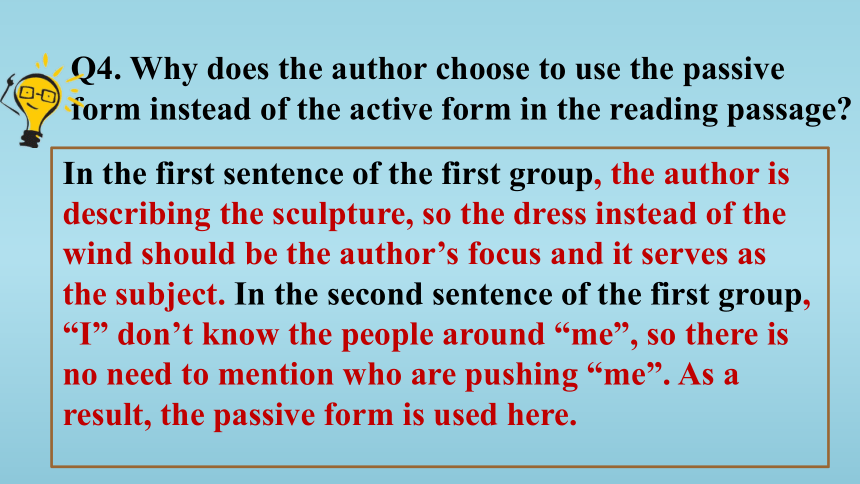
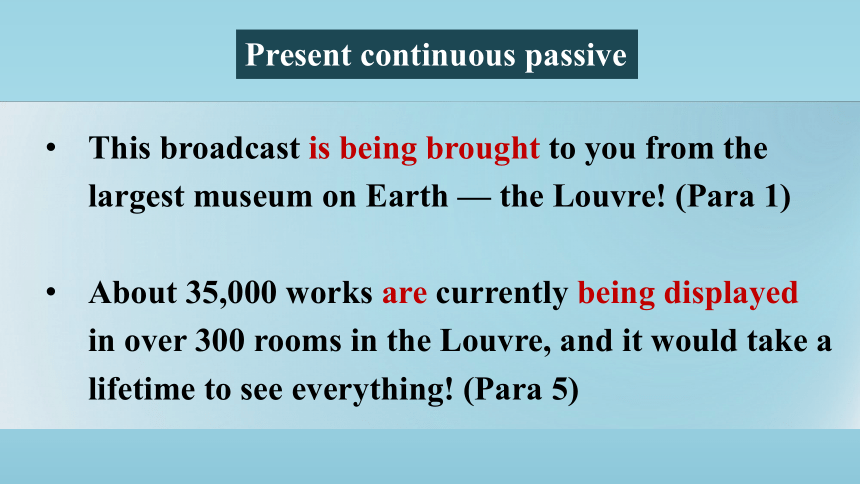
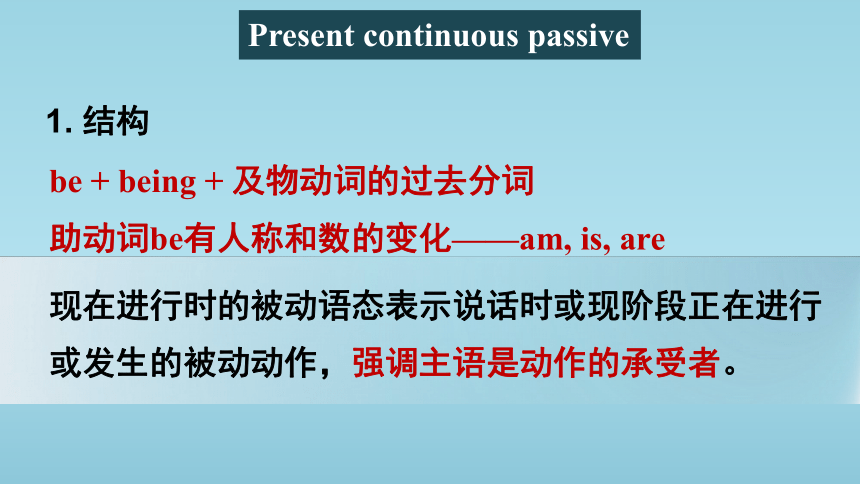
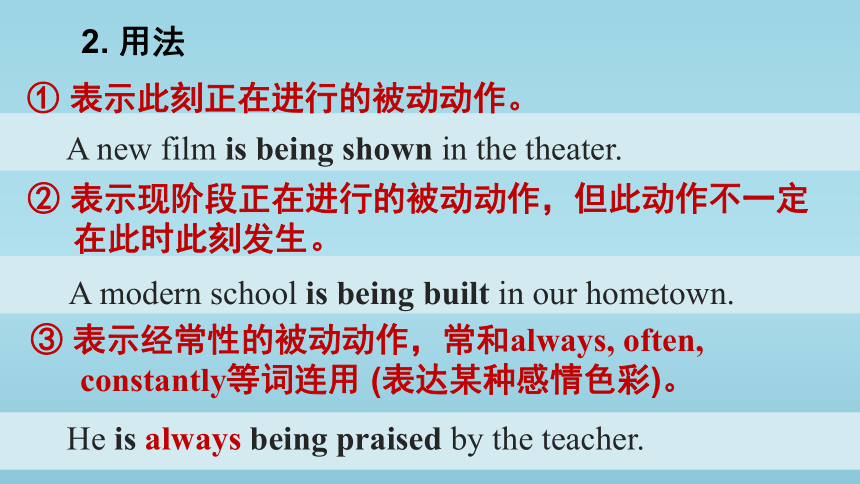

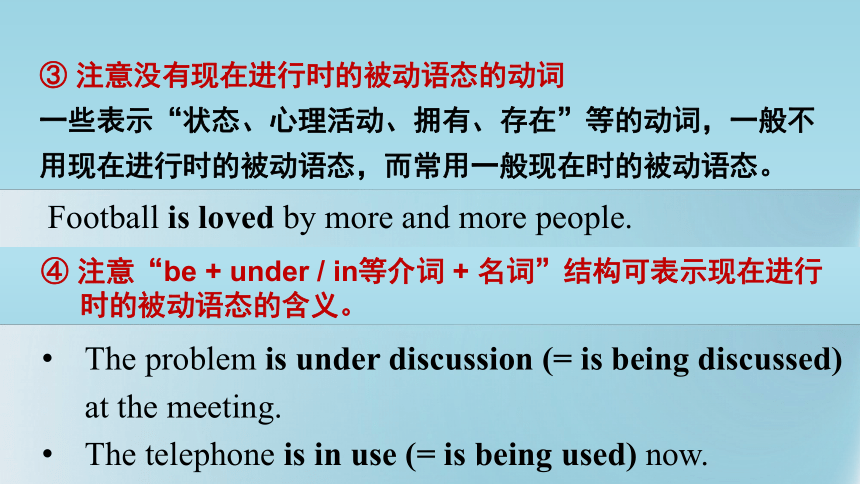
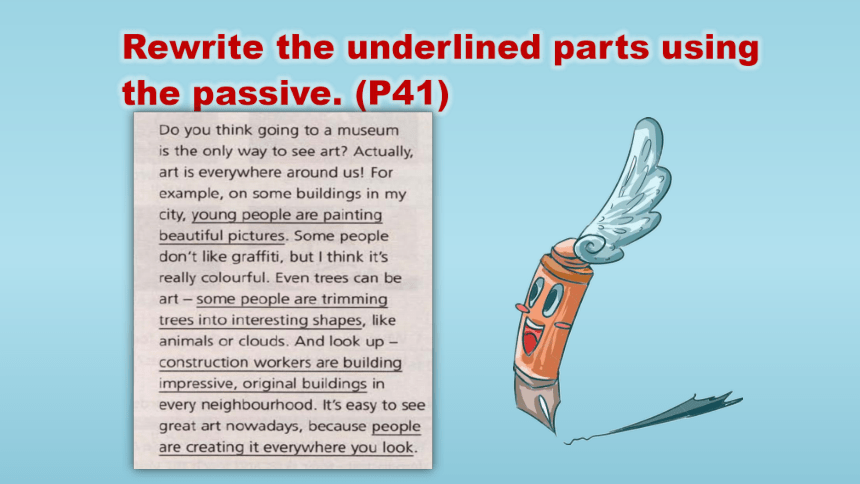
文档简介
(共35张PPT)
Using language
Unit 4 Amazing art
【版本:外研 册别:必修三】
contents
Grammar
Vocabulary building
Listening & speaking
Homework
Ⅰ
Ⅱ
Ⅲ
Ⅳ
I
Grammar
0,000 people reading my blog! b I love to photograph the rising sun, …
Look at the sentences from the reading passage(P41) and answer the questions.
And just look at how her dress is being folded by the wind!
I’m being pushed around quite a bit, in fact.
Q1. What causes the action in sentence (a)
The dress or the wind
People around “me” are pushing “me”.
Q2. What is happening to “me” in sentence (b)
0,000 people reading my blog! b I love to photograph the rising sun, …
Q3. What is the difference between the two groups
of sentences
Group(a, b)_____________.
Group(c, d)_____________.
passive form
active form
And just look at how her dress is being folded by the wind!
I’m being pushed around quite a bit, in fact.
c. And just look at how the wind is folding her dress!
d. People are pushing me around quite a bit, in fact.
Q4. Why does the author choose to use the passive form instead of the active form in the reading passage
In the first sentence of the first group, the author is describing the sculpture, so the dress instead of the wind should be the author’s focus and it serves as the subject. In the second sentence of the first group, “I” don’t know the people around “me”, so there is no need to mention who are pushing “me”. As a result, the passive form is used here.
Present continuous passive
This broadcast is being brought to you from the largest museum on Earth — the Louvre! (Para 1)
About 35,000 works are currently being displayed in over 300 rooms in the Louvre, and it would take a lifetime to see everything! (Para 5)
be + being + 及物动词的过去分词
助动词be有人称和数的变化——am, is, are
1. 结构
现在进行时的被动语态表示说话时或现阶段正在进行
或发生的被动动作,强调主语是动作的承受者。
Present continuous passive
2. 用法
① 表示此刻正在进行的被动动作。
A new film is being shown in the theater.
② 表示现阶段正在进行的被动动作,但此动作不一定
在此时此刻发生。
A modern school is being built in our hometown.
③ 表示经常性的被动动作,常和always, often,
constantly等词连用 (表达某种感彩)。
He is always being praised by the teacher.
3. 注意
① 注意不可遗漏being
Look! The children are being taken good care of by their aunt.
比较: Children are taken good care of at school.
② 注意不可忽视“现阶段”(可表示目前一阶段正在进行的一个
被动的动作)
Many interesting experiments are being carried out these days.
③ 注意没有现在进行时的被动语态的动词
一些表示“状态、心理活动、拥有、存在”等的动词,一般不
用现在进行时的被动语态,而常用一般现在时的被动语态。
Football is loved by more and more people.
④ 注意“be + under / in等介词 + 名词”结构可表示现在进行
时的被动语态的含义。
The problem is under discussion (= is being discussed) at the meeting.
The telephone is in use (= is being used) now.
Rewrite the underlined parts using the passive. (P41)
Do you think going to a museum is the only way to see art Actually, art is everywhere around us! For example, on some buildings in my city, young people are painting beautiful pictures. Some people don't like graffiti, but I think it's really colourful. Even trees can be art — some people are trimming
trees into interesting shapes, like
animals or clouds. And look up — construction workers are building impressive, original buildings in every neighbourhood. It's easy to see great art nowadays, because people are creating it everywhere you look.
beautiful pictures are being painted (by young people).
trees are being trimmed into interesting shapes,
Do you think going to a museum is the only way to see art Actually, art is everywhere around us! For example, on some buildings in my city, young people are painting beautiful pictures. Some people don't like graffiti, but I think it's really colourful. Even trees can be art — some people are trimming
trees into interesting shapes, like
animals or clouds. And look up — construction workers are building impressive, original buildings in every neighbourhood. It's easy to see great art nowadays, because people are creating it everywhere you look.
impressive, original buildings are being built
it is being created everywhere you look.
Describe what is happening using the passive form of the words and expressions in the box.
arrange carry hang paint put up sweep write
(P41)
Lamps are being arranged.
The wall is being painted.
A painting is being hung.
A banner is being put up.
A statue is being carried.
The floor is being swept.
Invitations are being written.
II
Vocabulary building
paper cutting
embroidery
seal cutting
calligraphy
Chinese painting
porcelain
What do you know about these art forms
Have you tried any of these art forms
Complete the passage with the words and expressions in the above activity.
(P42)
Yesterday, I went to an amazing Chinese art festival. There were different stands where artists could demonstrate their skills and teach the visitors! It was definitely an exciting experience for a foreign student like me.
What caught my attention first was a 15th-century qinghua bowl in a breathtaking exhibition of Chinese 1 _________.
It vividly illustrated a dragon playing with a ball.
porcelain
Then I tried some 2 ____________, that is, making images out of paper. It was difficult, but a lot of fun! With help from the artist, I managed to make one in the shape of a fish. Meanwhile, a woman at the next stand was using a needle and some thread to do some 3 ___________. It looked so
pretty! Then I went into a section decorated like a traditional Chinese study, with two beautiful 4 __________
_________ of a pine tree and some bamboo hung on the walls.
paper cutting
embroidery
Chinese
paintings
There was also an old man writing Chinese 5 __________: his writing was so free and elegant! Another man sitting
next to him showed me how 6___________ works. Chinese characters are carved into small squares of stone and stamped onto paper with ink. He made one for me with my name in Chinese — pretty awesome!
calligraphy
seal cutting
Talk about a Chinese art form that your home town is famous for.
Pair work
You may start like this:
My home town is famous for the traditional art of... People use... to...
III
Listening & speaking
Contemporary art
P43: Did you know
Did you know
Since it began in the late 20th century, the Contemporary Art Movement has raised questions and doubts, with
people asking, “Is it really art ” This was the case in 1999 with British artist Tracey Emin’s work, My bed — which was, quite literally, her unmade bed.
Then, in 2015, cleaners in an Italian gallery threw away an art piece after mistaking the pile of empty bottles, cigarette ends and pieces of coloured paper for rubbish! While some say contemporary art lacks skill, meaning and artistic value, others argue that its
worth lies in its ability to stimulate new
discussions and understanding of
everyday objects.
Listen to the conversation and choose the main idea. (P43)
1. Everyone can create art, whatever their background.
2. We can use art to learn about the world.
3. Art means different things to different people.
4. Everyone should try to include art in their lives.
Jill’s opinions Andrew’s opinions
It was boring and there was 1 _______________. It had 2 __________ for me. It was really clever and the viewer can 3
__________________.
It was rather lazy because the artist didn’t 4 _____________________. Everyday objects can also be art. I could 5 ____________________
when looking at the details.
nothing to look at
no meaning
decide what it means
actually create anything
tell how the artist lives
Listen again and complete the table.
Jill’s opinions Andrew’s opinions
It was just 6 _____________ anyone can make, and my cat would love to play in them.
That was my favourite piece and it really 7 ___________________
___________________.
a pile of boxes
explored the nature of art
Talk about how Jill and Andrew express their opinions towards contemporary artworks.
What do you think of...
I think it is...
I especially like...
I have to disagree because...
There’s a great deal of meaning in the work. For example, ...
I think the artist is saying...
There’s no meaning in the work. For example, ...
To be honest, I prefer...
Useful expressions
Pair work
Act out the conversation to share your opinions about the artwork.
Student A: Turn to Page 82.
Student B: Turn to Page 85.
IV
Homework
Summarize the usage of present continuous passive;
Think of another artwork and have a similar conversation.
Thanks
Using language
Unit 4 Amazing art
【版本:外研 册别:必修三】
contents
Grammar
Vocabulary building
Listening & speaking
Homework
Ⅰ
Ⅱ
Ⅲ
Ⅳ
I
Grammar
0,000 people reading my blog! b I love to photograph the rising sun, …
Look at the sentences from the reading passage(P41) and answer the questions.
And just look at how her dress is being folded by the wind!
I’m being pushed around quite a bit, in fact.
Q1. What causes the action in sentence (a)
The dress or the wind
People around “me” are pushing “me”.
Q2. What is happening to “me” in sentence (b)
0,000 people reading my blog! b I love to photograph the rising sun, …
Q3. What is the difference between the two groups
of sentences
Group(a, b)_____________.
Group(c, d)_____________.
passive form
active form
And just look at how her dress is being folded by the wind!
I’m being pushed around quite a bit, in fact.
c. And just look at how the wind is folding her dress!
d. People are pushing me around quite a bit, in fact.
Q4. Why does the author choose to use the passive form instead of the active form in the reading passage
In the first sentence of the first group, the author is describing the sculpture, so the dress instead of the wind should be the author’s focus and it serves as the subject. In the second sentence of the first group, “I” don’t know the people around “me”, so there is no need to mention who are pushing “me”. As a result, the passive form is used here.
Present continuous passive
This broadcast is being brought to you from the largest museum on Earth — the Louvre! (Para 1)
About 35,000 works are currently being displayed in over 300 rooms in the Louvre, and it would take a lifetime to see everything! (Para 5)
be + being + 及物动词的过去分词
助动词be有人称和数的变化——am, is, are
1. 结构
现在进行时的被动语态表示说话时或现阶段正在进行
或发生的被动动作,强调主语是动作的承受者。
Present continuous passive
2. 用法
① 表示此刻正在进行的被动动作。
A new film is being shown in the theater.
② 表示现阶段正在进行的被动动作,但此动作不一定
在此时此刻发生。
A modern school is being built in our hometown.
③ 表示经常性的被动动作,常和always, often,
constantly等词连用 (表达某种感彩)。
He is always being praised by the teacher.
3. 注意
① 注意不可遗漏being
Look! The children are being taken good care of by their aunt.
比较: Children are taken good care of at school.
② 注意不可忽视“现阶段”(可表示目前一阶段正在进行的一个
被动的动作)
Many interesting experiments are being carried out these days.
③ 注意没有现在进行时的被动语态的动词
一些表示“状态、心理活动、拥有、存在”等的动词,一般不
用现在进行时的被动语态,而常用一般现在时的被动语态。
Football is loved by more and more people.
④ 注意“be + under / in等介词 + 名词”结构可表示现在进行
时的被动语态的含义。
The problem is under discussion (= is being discussed) at the meeting.
The telephone is in use (= is being used) now.
Rewrite the underlined parts using the passive. (P41)
Do you think going to a museum is the only way to see art Actually, art is everywhere around us! For example, on some buildings in my city, young people are painting beautiful pictures. Some people don't like graffiti, but I think it's really colourful. Even trees can be art — some people are trimming
trees into interesting shapes, like
animals or clouds. And look up — construction workers are building impressive, original buildings in every neighbourhood. It's easy to see great art nowadays, because people are creating it everywhere you look.
beautiful pictures are being painted (by young people).
trees are being trimmed into interesting shapes,
Do you think going to a museum is the only way to see art Actually, art is everywhere around us! For example, on some buildings in my city, young people are painting beautiful pictures. Some people don't like graffiti, but I think it's really colourful. Even trees can be art — some people are trimming
trees into interesting shapes, like
animals or clouds. And look up — construction workers are building impressive, original buildings in every neighbourhood. It's easy to see great art nowadays, because people are creating it everywhere you look.
impressive, original buildings are being built
it is being created everywhere you look.
Describe what is happening using the passive form of the words and expressions in the box.
arrange carry hang paint put up sweep write
(P41)
Lamps are being arranged.
The wall is being painted.
A painting is being hung.
A banner is being put up.
A statue is being carried.
The floor is being swept.
Invitations are being written.
II
Vocabulary building
paper cutting
embroidery
seal cutting
calligraphy
Chinese painting
porcelain
What do you know about these art forms
Have you tried any of these art forms
Complete the passage with the words and expressions in the above activity.
(P42)
Yesterday, I went to an amazing Chinese art festival. There were different stands where artists could demonstrate their skills and teach the visitors! It was definitely an exciting experience for a foreign student like me.
What caught my attention first was a 15th-century qinghua bowl in a breathtaking exhibition of Chinese 1 _________.
It vividly illustrated a dragon playing with a ball.
porcelain
Then I tried some 2 ____________, that is, making images out of paper. It was difficult, but a lot of fun! With help from the artist, I managed to make one in the shape of a fish. Meanwhile, a woman at the next stand was using a needle and some thread to do some 3 ___________. It looked so
pretty! Then I went into a section decorated like a traditional Chinese study, with two beautiful 4 __________
_________ of a pine tree and some bamboo hung on the walls.
paper cutting
embroidery
Chinese
paintings
There was also an old man writing Chinese 5 __________: his writing was so free and elegant! Another man sitting
next to him showed me how 6___________ works. Chinese characters are carved into small squares of stone and stamped onto paper with ink. He made one for me with my name in Chinese — pretty awesome!
calligraphy
seal cutting
Talk about a Chinese art form that your home town is famous for.
Pair work
You may start like this:
My home town is famous for the traditional art of... People use... to...
III
Listening & speaking
Contemporary art
P43: Did you know
Did you know
Since it began in the late 20th century, the Contemporary Art Movement has raised questions and doubts, with
people asking, “Is it really art ” This was the case in 1999 with British artist Tracey Emin’s work, My bed — which was, quite literally, her unmade bed.
Then, in 2015, cleaners in an Italian gallery threw away an art piece after mistaking the pile of empty bottles, cigarette ends and pieces of coloured paper for rubbish! While some say contemporary art lacks skill, meaning and artistic value, others argue that its
worth lies in its ability to stimulate new
discussions and understanding of
everyday objects.
Listen to the conversation and choose the main idea. (P43)
1. Everyone can create art, whatever their background.
2. We can use art to learn about the world.
3. Art means different things to different people.
4. Everyone should try to include art in their lives.
Jill’s opinions Andrew’s opinions
It was boring and there was 1 _______________. It had 2 __________ for me. It was really clever and the viewer can 3
__________________.
It was rather lazy because the artist didn’t 4 _____________________. Everyday objects can also be art. I could 5 ____________________
when looking at the details.
nothing to look at
no meaning
decide what it means
actually create anything
tell how the artist lives
Listen again and complete the table.
Jill’s opinions Andrew’s opinions
It was just 6 _____________ anyone can make, and my cat would love to play in them.
That was my favourite piece and it really 7 ___________________
___________________.
a pile of boxes
explored the nature of art
Talk about how Jill and Andrew express their opinions towards contemporary artworks.
What do you think of...
I think it is...
I especially like...
I have to disagree because...
There’s a great deal of meaning in the work. For example, ...
I think the artist is saying...
There’s no meaning in the work. For example, ...
To be honest, I prefer...
Useful expressions
Pair work
Act out the conversation to share your opinions about the artwork.
Student A: Turn to Page 82.
Student B: Turn to Page 85.
IV
Homework
Summarize the usage of present continuous passive;
Think of another artwork and have a similar conversation.
Thanks
